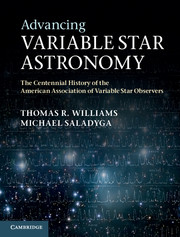 Advancing Variable Star Astronomy
Advancing Variable Star Astronomy from PART IV - THE SERVICE BUREAU – THE MARGARET MAYALL ERA
Published online by Cambridge University Press: 13 June 2011
One thing I can promise you, and that is if we are penniless I will not close the door and walk out!
– Margaret W. Mayall, 1954For the next decade, the American Association of Variable Star Observers, now without its Harvard Observatory support, found itself facing deficits in its operations and struggling to raise its own Endowment Fund with which to fund its operations.
Survival in this period must be credited to the continued tenacity and optimism of Director Margaret Mayall and many other officers and friends. Although there were “low” spots, she was also being encouraged by the responses from grant associations who were taking an interest in her initiatives in observing programs and publications. Yet, at the same time she was trying to make the Association's operations more efficient.
This chapter traces some of the ups and downs for the Association during the next 9 critical years of operations.
MOVE TO BRATTLE STREET
A small group of AAVSO members and friends gathered on a Saturday, January 2, 1954, to assist with the move to the new headquarters on Brattle Street. Among the helpers were Jackie Sweeney Kloss, Jean McCroskey, Virginia McKibben Nail, and Dorrit Hoffleit, all from the HCO scientific staff; and Franklin Marsh, Percy Witherell, Helen Stephansky, Newton Mayall, and Margaret Mayall of the AAVSO.
To save this book to your Kindle, first ensure no-reply@cambridge.org is added to your Approved Personal Document E-mail List under your Personal Document Settings on the Manage Your Content and Devices page of your Amazon account. Then enter the ‘name’ part of your Kindle email address below. Find out more about saving to your Kindle.
Note you can select to save to either the @free.kindle.com or @kindle.com variations. ‘@free.kindle.com’ emails are free but can only be saved to your device when it is connected to wi-fi. ‘@kindle.com’ emails can be delivered even when you are not connected to wi-fi, but note that service fees apply.
Find out more about the Kindle Personal Document Service.
To save content items to your account, please confirm that you agree to abide by our usage policies. If this is the first time you use this feature, you will be asked to authorise Cambridge Core to connect with your account. Find out more about saving content to Dropbox.
To save content items to your account, please confirm that you agree to abide by our usage policies. If this is the first time you use this feature, you will be asked to authorise Cambridge Core to connect with your account. Find out more about saving content to Google Drive.